Effects of neuronal nitric oxide synthase inhibition on resting and exercising hindlimb muscle blood flow in the rat
- PMID: 20176629
- PMCID: PMC2872736
- DOI: 10.1113/jphysiol.2009.183723
Effects of neuronal nitric oxide synthase inhibition on resting and exercising hindlimb muscle blood flow in the rat
Abstract
Nitric oxide (NO) derived from endothelial NO synthase (eNOS) is an integral mediator of vascular control during muscle contractions. However, it is not known whether neuronal NOS (nNOS)-derived NO regulates tissue hyperaemia in healthy subjects, particularly during exercise. We tested the hypothesis that selective nNOS inhibition would reduce blood flow and vascular conductance (VC) in rat hindlimb locomotor muscle(s), kidneys and splanchnic organs at rest and during dynamic treadmill exercise (20 m min(-1), 10% grade). Nineteen male Sprague-Dawley rats (555 +/- 23 g) were assigned to either rest (n = 9) or exercise (n = 10) groups. Blood flow and VC were determined via radiolabelled microspheres before and after the intra-arterial administration of the selective nNOS inhibitor S-methyl-L-thiocitrulline (SMTC, 2.1 +/- 0.1 micromol kg(-1)). Total hindlimb muscle blood flow (control: 20 +/- 2 ml min(-1) 100g(-1), SMTC: 12 +/- 2 ml min(-1) 100g(-1), P < 0.05) and VC (control: 0.16 +/- 0.02 ml min(-1) 100 g(-1) mmHg(1), SMTC: 0.09 +/- 0.01 ml min(-1) 100 g(-1) mmHg(-1), P < 0.05) were reduced substantially at rest. Moreover, the magnitude of the absolute reduction in blood flow and VC correlated (P < 0.05) with the proportion of oxidative muscle fibres found in the individual muscles or muscle parts of the hindlimb. During exercise, total hindlimb blood flow (control: 108 +/- 7 ml min(-1) 100 g(-1), SMTC: 105 +/- 8 ml min(-1) 100 g(-1)) and VC (control: 0.77 +/- 0.06 ml min(-1) 100g(-1) mmHg(-1); SMTC: 0.70 +/- 0.05 ml min(-1) 100g(-1) mmHg(-1)) were not different (P > 0.05) between control and SMTC conditions. SMTC reduced (P < 0.05) blood flow and VC at rest and during exercise in the kidneys, adrenals and liver. These results enhance our understanding of the role of NO-mediated circulatory control by demonstrating that nNOS does not appear to subserve an obligatory role in the exercising muscle hyperaemic response in the rat.
Figures

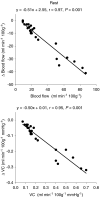
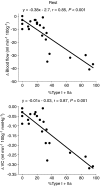
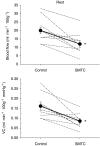
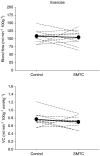
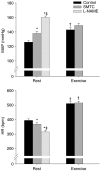

Similar articles
-
Nitric oxide synthase inhibition during treadmill exercise reveals fiber-type specific vascular control in the rat hindlimb.Am J Physiol Regul Integr Comp Physiol. 2010 Feb;298(2):R478-85. doi: 10.1152/ajpregu.00631.2009. Epub 2009 Dec 9. Am J Physiol Regul Integr Comp Physiol. 2010. PMID: 20007515 Free PMC article.
-
Muscle fibre-type dependence of neuronal nitric oxide synthase-mediated vascular control in the rat during high speed treadmill running.J Physiol. 2013 Jun 1;591(11):2885-96. doi: 10.1113/jphysiol.2013.251082. Epub 2013 Mar 18. J Physiol. 2013. PMID: 23507879 Free PMC article.
-
Role of neuronal nitric oxide in the inhibition of sympathetic vasoconstriction in resting and contracting skeletal muscle of healthy rats.J Appl Physiol (1985). 2013 Jul 1;115(1):97-106. doi: 10.1152/japplphysiol.00250.2013. Epub 2013 May 2. J Appl Physiol (1985). 2013. PMID: 23640592
-
Effects of neuronal nitric oxide synthase inhibition on microvascular and contractile function in skeletal muscle of aged rats.Am J Physiol Heart Circ Physiol. 2012 Oct 15;303(8):H1076-84. doi: 10.1152/ajpheart.00477.2012. Epub 2012 Aug 24. Am J Physiol Heart Circ Physiol. 2012. PMID: 22923618 Free PMC article.
-
Neuronal nitric oxide synthase and human vascular regulation.Trends Cardiovasc Med. 2009 Nov;19(8):256-62. doi: 10.1016/j.tcm.2010.02.007. Trends Cardiovasc Med. 2009. PMID: 20447567 Free PMC article. Review.
Cited by
-
The effect of nitric oxide synthase inhibition with and without inhibition of prostaglandins on blood flow in different human skeletal muscles.Eur J Appl Physiol. 2017 Jun;117(6):1175-1180. doi: 10.1007/s00421-017-3604-2. Epub 2017 Apr 21. Eur J Appl Physiol. 2017. PMID: 28432421
-
Does sympathetic vasoconstriction contribute to metabolism: Perfusion matching in exercising skeletal muscle?Front Physiol. 2022 Sep 12;13:980524. doi: 10.3389/fphys.2022.980524. eCollection 2022. Front Physiol. 2022. PMID: 36171966 Free PMC article. Review.
-
Neuronal nitric oxide synthase inhibition and regional sympathetic nerve discharge: implications for peripheral vascular control.Respir Physiol Neurobiol. 2013 May 1;186(3):285-9. doi: 10.1016/j.resp.2013.02.021. Epub 2013 Feb 27. Respir Physiol Neurobiol. 2013. PMID: 23454026 Free PMC article.
-
Erythrocyte-dependent regulation of human skeletal muscle blood flow: role of varied oxyhemoglobin and exercise on nitrite, S-nitrosohemoglobin, and ATP.Am J Physiol Heart Circ Physiol. 2010 Dec;299(6):H1936-46. doi: 10.1152/ajpheart.00389.2010. Epub 2010 Sep 17. Am J Physiol Heart Circ Physiol. 2010. PMID: 20852046 Free PMC article.
-
Imaging of small animal peripheral artery disease models: recent advancements and translational potential.Int J Mol Sci. 2015 May 18;16(5):11131-77. doi: 10.3390/ijms160511131. Int J Mol Sci. 2015. PMID: 25993289 Free PMC article. Review.
References
-
- Buckwalter JB, Taylor JC, Hamann JJ, Clifford PS. Role of nitric oxide in exercise sympatholysis. J Appl Physiol. 2004;97:417–423. - PubMed
-
- Clifford PS, Hellsten Y. Vasodilatory mechanisms in contracting skeletal muscle. J Appl Physiol. 2004;97:393–403. - PubMed
-
- Delp MD, Duan C. Composition and size of type I, IIA, IID/X, and IIB fibres and citrate synthase activity of rat muscle. J Appl Physiol. 1996;80:261–270. - PubMed
Publication types
MeSH terms
Substances
LinkOut - more resources
Full Text Sources
Miscellaneous

